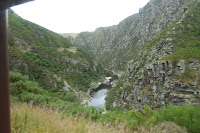The ship entered Duneden harbour early in the morning, accompanied by a pilot boat, and passing wharves filled with pine logs ready for shipment. The sheer amount of cut plantation timber we saw was staggering. The ship then docked at Port Chalmers.
After disembarking we were met by a double-decker bus and taken to the Dunedin Railway Station.
 At the station we boarded a train for our booked journey of a 4-hour round trip on the Taieri Railway which into the spectacular Central Otago Hinterland and up the rugged Otago coast north of Dunedin to Pukerangi.
At the station we boarded a train for our booked journey of a 4-hour round trip on the Taieri Railway which into the spectacular Central Otago Hinterland and up the rugged Otago coast north of Dunedin to Pukerangi.
Doing this way was considerably cheaper than booking a day tour via the ship, but we did miss out on a served lunch on board, making do with filled bread rolls which we had packed at breakfast on the ship.
The line is shared with regular rail transport, but ours was a dedicated historic train. The track was cut through mountains and traversed narrow timber bridges across deep valleys. Some of the bridges and tunnels are shared with vehicular traffic, so some caution is needed when approaching any of them.
There was not much in Pukerangi except for an arts and craft market, so after a stay while the diesel engine was moved from one ent to the other end of the train, we headed back to Duniden.
 Our bus took us on a short tour of Dunedin, then dropped us off in the city centre to spend an hour or so exploring. I bought a Vodafone chip for my phone so that we could have internet access and we also bought some New Zealand Rosé (which we later discovered was very good) to take back to the ship.
Our bus took us on a short tour of Dunedin, then dropped us off in the city centre to spend an hour or so exploring. I bought a Vodafone chip for my phone so that we could have internet access and we also bought some New Zealand Rosé (which we later discovered was very good) to take back to the ship.
Then we caught a shuttle bus back to Port Chalmers (Koputai) which is a charming historic little town. We visited the Port Chalmers Museum which was dedicated to the maritime history of the area.
The exhibits included a cute model of the interior of a ship, constructed within a hat box.
 |
| Entering the port of Dunedin |
 |
| Timber ready for transport |
 |
| Pilot boat |
After disembarking we were met by a double-decker bus and taken to the Dunedin Railway Station.
 At the station we boarded a train for our booked journey of a 4-hour round trip on the Taieri Railway which into the spectacular Central Otago Hinterland and up the rugged Otago coast north of Dunedin to Pukerangi.
At the station we boarded a train for our booked journey of a 4-hour round trip on the Taieri Railway which into the spectacular Central Otago Hinterland and up the rugged Otago coast north of Dunedin to Pukerangi.Doing this way was considerably cheaper than booking a day tour via the ship, but we did miss out on a served lunch on board, making do with filled bread rolls which we had packed at breakfast on the ship.
The line is shared with regular rail transport, but ours was a dedicated historic train. The track was cut through mountains and traversed narrow timber bridges across deep valleys. Some of the bridges and tunnels are shared with vehicular traffic, so some caution is needed when approaching any of them.
There was not much in Pukerangi except for an arts and craft market, so after a stay while the diesel engine was moved from one ent to the other end of the train, we headed back to Duniden.
 Our bus took us on a short tour of Dunedin, then dropped us off in the city centre to spend an hour or so exploring. I bought a Vodafone chip for my phone so that we could have internet access and we also bought some New Zealand Rosé (which we later discovered was very good) to take back to the ship.
Our bus took us on a short tour of Dunedin, then dropped us off in the city centre to spend an hour or so exploring. I bought a Vodafone chip for my phone so that we could have internet access and we also bought some New Zealand Rosé (which we later discovered was very good) to take back to the ship.Then we caught a shuttle bus back to Port Chalmers (Koputai) which is a charming historic little town. We visited the Port Chalmers Museum which was dedicated to the maritime history of the area.
The exhibits included a cute model of the interior of a ship, constructed within a hat box.


















